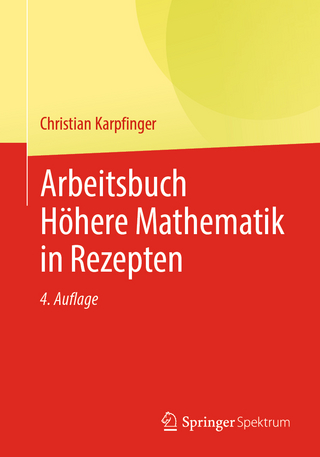
Associative Algebras
Springer-Verlag New York Inc.
978-1-4757-0165-4 (ISBN)
1 The Associative Algebra.- 1.1. Conventions.- 1.2. Group Algebras.- 1.3. Endomorphism Algebras.- 1.4. Matrix Algebras.- 1.5. Finite Dimensional Algebras over a Field.- 1.6. Quaternion Algebras.- 1.7. Isomorphism of Quaternion Algebras.- 2 Modules.- 2.1. Change of Scalars.- 2.2. The Lattice of Submodules.- 2.3. Simple Modules.- 2.4. Semisimple Modules.- 2.5. Structure of Semisimple Modules.- 2.6. Chain Conditions.- 2.7. The Radical.- 3 The Structure of Semisimple Algebras.- 3.1. Semisimple Algebras.- 3.2. Minimal Right Ideals.- 3.3. Simple Algebras.- 3.4. Matrices of Homomorphisms.- 3.5. Wedderbum’s Structure Theorem.- 3.6. Maschke’s Theorem.- 4 The Radical.- 4.1. The Radical of an Algebra.- 4.2. Nakayama’s Lemma.- 4.3. The Jacobson Radical.- 4.4. The Radical of an Artinian Algebra.- 4.5. Artinian Algebras Are Noetherian.- 4.6. Nilpotent Algebras.- 4.7. The Radical of a Group Algebra.- 4.8. Ideals in Artinian Algebras.- 5 Indecomposable Modules.- 5.1. Direct Decompositions.- 5.2. Local Algebras.- 5.3. Fitting’s Lemma.- 5.4. The Krull-Schmidt Theorem.- 5.5. Representations of Algebras.- 5.6. Indecomposable and Irreducible Representations.- 6 Projective Modules over Artinian Algebras.- 6.1. Projective Modules.- 6.2. Homomorphisms of Projective Modules.- 6.3. Structure of Projective Modules.- 6.4. Idempotents.- 6.5. Structure of Artinian Algebras.- 6.6. Basic Algebras.- 6.7. Representation Type.- 7 Finite Representation Type.- 7.1. The Brauer-Thrall Conjectures.- 7.2. Bounded Representation Type.- 7.3. Sequence Categories.- 7.4. Simple Sequences.- 7.5. Almost Split Sequences.- 7.6. Almost Split Extensions.- 7.7. Roiter’s Theorem.- 8 Representation of Quivers.- 8.1. Constructing Modules.- 8.2. Representation of Quivers.- 8.3. Application to Algebras.- 8.4.Subquivers.- 8.5. Rigid Representations.- 8.6. Change of Orientation.- 8.7. Change of Representation.- 8.8. The Quadratic Space of a Quiver.- 8.9. Roots and Representations.- 9 Tensor Products.- 9.1. Tensor Products of R-modules.- 9.2. Tensor Products of Algebras.- 9.3. Tensor Products of Modules over Algebras.- 9.4. Scalar Extensions.- 9.5. Induced Modules.- 9.6. Morita Equivalence.- 10 Separable Algebras.- 10.1. Bimodules.- 10.2. Separability.- 10.3. Separable Algebras Are Finitely Generated.- 10.4. Categorical Properties.- 10.5. The Class of Separable Algebras.- 10.6. Extensions of Separable Algebras.- 10.7. Separable Algebras over Fields.- 10.8. Separable Extensions of Algebras.- 11 The Cohomology of Algebras.- 11.1. Hochschild Cohomology.- 11.2. Properties of Cohomology.- 11.3. The Snake Lemma.- 11.4. Dimension.- 11.5. Zero Dimensional Algebras.- 11.6. The Principal Theorem.- 11.7. Split Extensions of Algebras.- 11.8. Algebras with 2-nilpotent Radicals.- 12 Simple Algebras.- 12.1. Centers of Simple Algebras.- 12.2. The Density Theorem.- 12.3. The Jacobson-Bourbaki Theorem.- 12.4. Central Simple Algebras.- 12.5. The Brauer Group.- 12.6. The Noether-Skolem Theorem.- 12.7. The Double Centralizer Theorem.- 13 Subfields of Simple Algebras.- 13.1. Maximal Subfields.- 13.2. Splitting Fields.- 13.3. Algebraic Splitting Fields.- 13.4. The Schur Index.- 13.5. Separable Splitting Fields.- 13.6. The Cartan-Brauer-Hua Theorem.- 14 Galois Cohomology.- 14.1. Crossed Products.- 14.2. Cohomology and Brauer Groups.- 14.3. The Product Theorem.- 14.4. Exponents.- 14.5. Inflation.- 14.6. Direct Limits.- 14.7. Restriction.- 15 Cyclic Division Algebras.- 15.1. Cyclic Algebras.- 15.2. Constructing Cyclic Algebras by Inflation.- 15.3. The Primary Decomposition of Cyclic Algebras.- 15.4. Characterizing Cyclic Division Algebras.- 15.5. Division Algebras of Prime Degree.- 15.6. Division Algebras of Degree Three.- 15.7. A Non-cyclic Division Algebra.- 16 Norms.- 16.1. The Characteristic Polynomial.- 16.2. Computations.- 16.3. The Reduced Norm.- 16.4. Transvections and Dilatations.- 16.5. Non-commutative Determinants.- 16.6. The Reduced Whitehead Group.- 17 Division Algebras over Local Fields.- 17.1. Valuations of Division Algebras.- 17.2. Non-archimedean Valuations.- 17.3. Valuation Rings.- 17.4. The Topology of a Valuation.- 17.5. Local Fields.- 17.6. Extension of Valuations.- 17.7. Ramification.- 17.8. Unramified Extensions.- 17.9. Norm Factor Groups.- 17.10. Brauer Groups of Local Fields.- 18 Division Algebras over Number Fields.- 18.1. Field Composita.- 18.2. More Extensions of Valuations.- 18.3. Valuations of Algebraic Number Fields.- 18.4. The Albert-Hasse-Brauer-Noether Theorem.- 18.5. The Brauer Groups of Algebraic Number Fields.- 18.6. Cyclic Algebras over Number Fields.- 18.7. The Image of INV.- 19 Division Algebras over Transcendental Fields.- 19.1. The Norm Form.- 19.2. Quasi-algebraically Closed Fields.- 19.3. Krull’s Theorem.- 19.4. Tsen’s Theorem.- 19.5. The Structure of B(K(x)/F(x)).- 19.6. Exponents of Division Algebras.- 19.7. Twisted Laurent Series.- 19.8. Laurent Series Fields.- 19.9. Amitsur’s Example.- 20 Varieties of Algebras.- 20.1. Polynomial Identities and Varieties.- 20.2. Special Identities.- 20.3. Identities for Central Simple Algebras.- 20.4. Standard Identities.- 20.5. Generic Matrix Algebras.- 20.6. Central Polynomials.- 20.7. Structure Theorems.- 20.8. Universal Division Algebras.- References.- Index of Symbols.- Index of Terms.
| Reihe/Serie | Graduate Texts in Mathematics ; 88 |
|---|---|
| Zusatzinfo | 436 p. |
| Verlagsort | New York, NY |
| Sprache | englisch |
| Maße | 155 x 235 mm |
| Themenwelt | Mathematik / Informatik ► Mathematik ► Algebra |
| Schlagworte | Algebra • Algebras • Assoziative Algebra |
| ISBN-10 | 1-4757-0165-9 / 1475701659 |
| ISBN-13 | 978-1-4757-0165-4 / 9781475701654 |
| Zustand | Neuware |
| Informationen gemäß Produktsicherheitsverordnung (GPSR) | |
| Haben Sie eine Frage zum Produkt? |
aus dem Bereich


